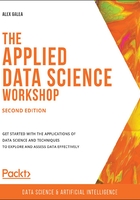
Introduction
So far, we have taken a glance at the data science ecosystem and jumped into learning about Jupyter, the tool that we'll be using throughout this book for our coding exercises and activities. Now, we'll shift our focus away from learning about Jupyter and start actually using it for analysis.
Data visualization and exploration are important steps in the data science process. This is how you can learn about your data and make sure you understand it completely. Visualizations can be used as a means of discovering unusual records in datasets and presenting that information to others.
In addition to understanding and gaining fundamental trust in data, your analysis may lead to the discovery of patterns and insights in the data. In some cases, these patterns can prompt further research and ultimately be very beneficial to your business.
Applied knowledge of a high-level programming language such as Python or R will make datasets accessible to you, from top-level aggregations to granular details. However, it's also possible to learn a lot from data with tools that are easier to pick up and use, such as Tableau or Microsoft Power BI.
In addition to learning about the tools to create them, it's important to have a conceptual understanding of different types of visualizations and their uses. Similarly, there are a handful of important techniques relating to data exploration, such as aggregation and filtering for outliers or missing samples.
In this chapter, we'll start out by learning about some of the basics of working with datasets in Jupyter by using pandas DataFrames. Then, we'll learn about exploring datasets with the Seaborn visualization library and do basic modeling with scikit learn.